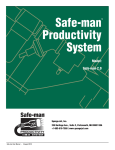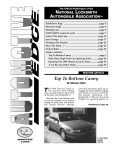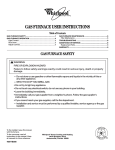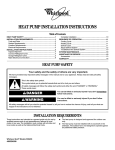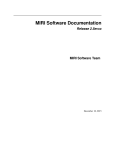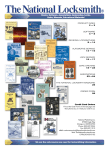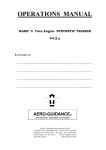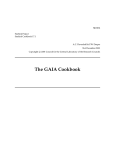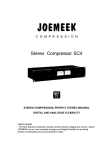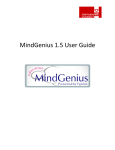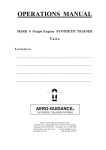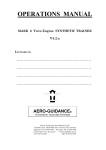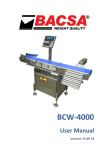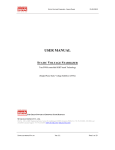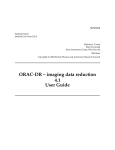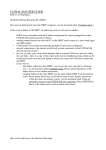Download 1.1-D-035-G WFCAM Functional and Performance Requirements v2
Transcript
Document Title WFCAM Functional and Performance Requirements Document Number 1.1 d 035 G Issue 2.2 Date 9/02/04 Document Prepared By: Mark Casali Signature and Date Document Approved By: Signature and Date Document Released By: Signature and Date H:\ukirt\WFCAM\Documents\Active\1.1-D-035-G Function and Performance Requirments v2.2.doc Document Number: Issue: Category: Staus: Author: Date: 1.1 d 035 G 2.2 Systems Issued M Casali 9/2/04 CHANGE RECORD Issue 1.0 Date 10/1/01 Section affected 1.1 29/01/01 Alterations following talk with Steve Warren. MMC. 1.2 15/02/01 Revised FPRD following requirements review. MMC. 1.3 25/04/01 1.4 13/09/01 All Inserted WCS astrometry and MEF format requirements after S/W meeting with CASU/WFAU Reformed document (VR) 1.5 26/09/01 1.3, 1.6, 1.12, 1.15, 1.17 1.6 22/10/01 All Inserted bright magnitude limits in 1.3. Revised tip-tilt spec in 1.6. Revised filter definitions 1.12. Rewording of system efficiency 1.15. Added autoguider/focal plane flexure requirement in 1.17. Throughput requirement set equal to UFTI. MMC. Revised following discussion with WFCAM team. 1.7 15/4/02 1.9, 1.18 Revised section 1.9. Modified mass limits in 1.18. 1.8 2/10/02 2.4d Removed 48 hour cool-down requirement. 1.18d Lifting-mass limit unchanged at 1250 kg. 1.18e Included CoG specification 2.4f Removed requirement on ability to pre-cool while on telescope. 1.17h Change Description First draft. MMC. Added full-frame AG CCD readout capability 1.17d Guide star mag limit no longer relevant - performance now required within observing efficiency budget. 2.0 27/1/03 2.1 Revised deliverable documents 2.1 23/7/03 1.16d, 1.16f, 1.16i, 1.17f, 2.9a These sections removed following transfer of responsibilities to JAC and CASU. 1.16d Inserted requirement for engineering pipeline. 2.2c Added note on list of spare parts. 1.17g Removed requirement for change to UKIRT pointing model. Will use current model as agreed with JAC. 1.7c 2.7 1.11 2.2 2 of 13 9/02/04 1.9a Added requirement to provide M2 vector description as a function of telescope attitude. Added details of auxiliary handling equipment. Refererence to ukirt pointing model included modifed to 94% spacing H:\ukirt\WFCAM\DOCUMENTS\Active\1.1-D-035-G WFCAM Functional and Performance Requirements v2.2.doc Document Number: Issue: Category: Staus: Author: Date: 1.1 d 035 G 2.2 Systems Issued M Casali 9/2/04 APPLICABLE DOCUMENTS Reference Document Title Document Number Issue & Date AD1 Operational Concepts Definition Document 1.1 d 040 G V1.2. 1/11/01 3 of 13 H:\ukirt\WFCAM\DOCUMENTS\Active\1.1-D-035-G WFCAM Functional and Performance Requirements v2.2.doc Document Number: Issue: Category: Staus: Author: Date: 1.1 d 035 G 2.2 Systems Issued M Casali 9/2/04 TABLE OF CONTENTS DOCUMENT FLOW ........................................................................................................................................... 5 INTRODUCTION ................................................................................................................................................ 6 1. INSTRUMENT ............................................................................................................................................ 7 1.1 1.2 1.3 1.4 1.5 1.6 1.7 1.8 1.9 1.10 1.11 1.12 1.13 1.14 1.15 1.16 1.17 1.18 2. FUNCTIONS ............................................................................................................................................ 7 NUMBER AND TYPE OF DETECTORS ........................................................................................................ 7 CHARACTERISTICS OF DETECTOR-CONTROLLER OPERATION ................................................................. 7 BACKROUND AND THROUGHPUT ........................................................................................................... 7 PIXEL SIZE AND MICROSTEPPING ........................................................................................................... 7 TIP-TILT SECONDARY MIRROR................................................................................................................ 7 OPTICAL IMAGE QUALITY...................................................................................................................... 8 GHOSTING AND STRAYLIGHT ................................................................................................................. 8 FOCAL PLANE LAYOUT ........................................................................................................................... 8 PHOTOMETRIC ACCURACY .................................................................................................................... 8 ASTROMETRY ........................................................................................................................................ 8 FILTERS.................................................................................................................................................. 9 COLD STOP ............................................................................................................................................ 9 FOCUSSING ............................................................................................................................................ 9 SYSTEM SURVEY EFFICIENCY ................................................................................................................ 9 OPERATING MODES AND DATA HANDLING ............................................................................................ 9 AUTOGUIDER ....................................................................................................................................... 10 MECHANICAL STIFFNESS, STABILITY AND MASS.................................................................................. 10 OPERATIONAL REQUIREMENTS ...................................................................................................... 11 2.1 2.2 2.3 2.4 2.5 2.6 2.7 2.8 2.9 2.10 DOCUMENTATION ................................................................................................................................ 11 SPARE PARTS ....................................................................................................................................... 11 WFCAM PRE-INSTALLATION .............................................................................................................. 11 WFCAM CRYOGENICS AND COOL-DOWN TIMES ................................................................................. 12 POWER LOSS/BAD WEATHER ................................................................................................................ 12 WINDOW CONDENSATION .................................................................................................................... 12 INSTALLATION AND HANDLING RIGS .................................................................................................... 12 MONITORING WFCAM STATUS ........................................................................................................... 12 MONITORING DATA QUALITY .............................................................................................................. 12 SAFETY ................................................................................................................................................ 13 4 of 13 H:\ukirt\WFCAM\DOCUMENTS\Active\1.1-D-035-G WFCAM Functional and Performance Requirements v2.2.doc Document Number: Issue: Category: Staus: Author: Date: 1.1 d 035 G 2.2 Systems Issued M Casali 9/2/04 DOCUMENT FLOW WFCAM Requirements Documents Sunday, October 21, 2001 Science Programme Functional and Performance Requirements Operational Concepts Definition Costs & schedule constraints System Budgets Sub-system specifications Sub-System Design 5 of 13 H:\ukirt\WFCAM\DOCUMENTS\Active\1.1-D-035-G WFCAM Functional and Performance Requirements v2.2.doc Document Number: Issue: Category: Staus: Author: Date: 1.1 d 035 G 2.2 Systems Issued M Casali 9/2/04 INTRODUCTION The top-level requirements and specifications for WFCAM which emerge from consideration of the science goals and modes of operation are set out below. Broadly, these requirements attempt to ensure that the end product of WFCAM observations is the desired science. They are the result of ongoing revisions of the FPRD first presented at the WFCAM Conceptual Design Review in 1999. Requirements deriving directly from instrument functionality and performance are presented in section 1. Those deriving from operational and instrument-support considerations are in section 2. Background information to the requirements is presented in the Appendix. 6 of 13 H:\ukirt\WFCAM\DOCUMENTS\Active\1.1-D-035-G WFCAM Functional and Performance Requirements v2.2.doc Document Number: Issue: Category: Staus: Author: Date: 1. INSTRUMENT 1.1 FUNCTIONS 1.1 d 035 G 2.2 Systems Issued M Casali 9/2/04 WFCAM will be an imager only. 1.2 NUMBER AND TYPE OF DETECTORS WFCAM will use 4 Hawaii-2 PACE HgCdTe detectors 1.3 CHARACTERISTICS OF DETECTOR-CONTROLLER OPERATION a. The detector-controller combination shall be such that in operation under highest background conditions, the system will not saturate on stars as bright as J=15, H=14, K=13.5 b. The electrical crosstalk rejection in the controllers shall be more than 94 db. c. The system noise in a single Correlated Double Sample will be less than 36 electrons. d. The controller will allow the following read schemes : (i) correlated double sampling, (ii) multiple (up to 100) non-destructive reads, (iii) row-by-row read-reset-read. (iv) sub-array readout allowing exposures shorter than 0.2 seconds. e. Individual detector assemblies and the entire focal plane itself must be safe against electrostatic damage with normal operational handling. 1.4 BACKROUND AND THROUGHPUT a. Removed. Identical to 1.3a. b. The internal cryostat thermal background must not add more than 5% to the total background (including sky emission) in any filter. The Telescope + WFCAM throughput, excluding filter and detector, should be greater than 60% in all bands and over the entire science field. 1.5 PIXEL SIZE AND MICROSTEPPING a. The pixel size will be 0.40 ± 0.004 (1%) arcsecond/pixel at 2.2 microns over the whole field. b. WFCAM/UKIRT shall be capable of accurate microstepping to +/- 0.033 arcseconds (1/12 of an IR pixel) over a region of +/- 8 arcseconds (+/-20 IR pixels). c. The definition of the number of microsteps and their precise offsets should be definable in software for 1 (no microstepping), 2x2, and 3x3 patterns. 1.6 TIP-TILT SECONDARY MIRROR a WFCAM shall have a tip-tilt secondary mirror & hexapod. b. The M2 loop control shall be capable of operating at faster than 85 Hz. c. The full system latency (measured from the centre of the CCD integration) shall be less than 25 ms. 7 of 13 H:\ukirt\WFCAM\DOCUMENTS\Active\1.1-D-035-G WFCAM Functional and Performance Requirements v2.2.doc Document Number: Issue: Category: Staus: Author: Date: 1.7 1.1 d 035 G 2.2 Systems Issued M Casali 9/2/04 OPTICAL IMAGE QUALITY a. Optics Encircled Energy requirement : 80% EE within 2.sec(z)3/5 " diameter; goal: 80% EE within 1.2.sec(z)3/5 " b. Optics MTF requirement : >0.5/sec(z)3/5 at 1.2 cycles per arcsecond following refocusing and hexapod (secondary mirror) adjustment from a look-up table. z is the Zenith angle of the observations. These requirements apply over the whole science field. c. The project shall supply a table or formula for the calculation of M2 position vectors as a function of telescope attitude. 1.8 GHOSTING AND STRAYLIGHT a. Ghosts and stray light arising from a point source in the field should have a peak intensity < 0.1% of the point source peak itself. b. Total diffuse stray light from a uniform background (sky) should not add more than 5% to the background, and should not vary by more than 10% on scales below 14 arc minutes. 1.9 FOCAL PLANE LAYOUT a. The focal plane configuration shall have 4 detectors spaced by 94 ± 1 % of their active area on a NSEW grid. b. The row and column directions of the detectors shall be co-aligned to within 0.5 degrees. c. The 4 detectors shall be sufficiently co-planar to achieve the required image quality. 1.10 PHOTOMETRIC ACCURACY WFCAM instrumental characteristics should not stop the achievement of relative photometric accuracy between point sources in a single IR science field at a level of 1% after routine calibration. 1.11 ASTROMETRY a. WFCAM instrumental characteristics should not stop the achievement of relative astrometric accuracy between point sources in a single IR science field of 0.1", with a goal of reaching 0.05". b. WFCAM shall use the UKIRT pointing model. 8 of 13 H:\ukirt\WFCAM\DOCUMENTS\Active\1.1-D-035-G WFCAM Functional and Performance Requirements v2.2.doc Document Number: Issue: Category: Staus: Author: Date: 1.12 1.1 d 035 G 2.2 Systems Issued M Casali 9/2/04 FILTERS WFCAM shall have a minimum of 6 filter mechanisms (goal of 8) with the following filters. Wavelengths are for normal incidence except where otherwise stated. filter blank Y J98 H98 K98 H2 1-0 S1 50% point– short λ - µm 50% point – long λ - µm peak transmission 0.97 1.17 1.49 2.03 2.111 * 1.07 1.33 1.78 2.37 2.132 * >80% >90% >90% >95% >75% Out of band transmission specification 0.1% 0.1% 0.1% 0.1% 0.1% * For an incident angle of 10 degrees at operating temperature. 1.13 COLD STOP WFCAM shall have a cold stop at a re-imaged pupil. 1.14 FOCUSSING The camera must be delivered with warm and cryogenic focussing procedures and mechanisms sufficient to allow the optical quality requirements to be achieved and maintained. 1.15 SYSTEM SURVEY EFFICIENCY For a survey which uses a 2x2 microstep and 10 seconds integration at each microstep point, the system efficiency defined as (photon integration time)/(elapsed time), averaged over a night shall be greater than 65%. 1.16 OPERATING MODES AND DATA HANDLING a. The telescope and camera combination should function semi-automatically, mapping large areas of sky, with operator intervention required only to start a new survey or to attend to acquisition or observing failures. b. It will be the WFCAM Project’s task to define interfaces with the Wide Field Astronomy groups and to follow and help co-ordinate the progress towards a streamlined pipeline from the summit to the end user in the UK, until completion of WFCAM summit commissioning. c. WFCAM must present a user-friendly interface in the manner of other common-user instruments for visiting astronomers. d. An engineering pipeline running under ORACDR will be delivered to enable instrument performance to be checked during integration and test, and commissioning. Major instrumental characteristics will be removed, and object extraction done. 9 of 13 H:\ukirt\WFCAM\DOCUMENTS\Active\1.1-D-035-G WFCAM Functional and Performance Requirements v2.2.doc Document Number: Issue: Category: Staus: Author: Date: 1.1 d 035 G 2.2 Systems Issued M Casali 9/2/04 e. Raw data for distribution to the Wide Field Astronomy Units will be in a mutually agreed format. f. Removed. g. It must be possible to carry out calibration observations required at appropriate points in the night. h. The WFCAM project will deliver hardware for the summit pipeline which measures data quality and warns of problems. i. Removed. j. WFCAM must have an engineering mode in which sub-systems can be controlled and exposures taken without requiring a full survey definition to be entered. k. WFCAM shall have simple start-up and shut-down procedures. 1.17 AUTOGUIDER a. The autoguider must be able to automatically acquire a guide star within a box of up to +/-8 arcsec on a side centred on the guide star catalogue position. b. Any flexure between autoguider and science focal plane must be less than 1.5 microns (0.033 arcsec) over 10 minutes of observing at zenith. c. Observing preparation tools must assign guide stars for each pointing off-line, from catalogues. d. Removed. Replaced by autoguider observing efficiency budget. e. The autoguider must satisfy the microstepping requirements. f. Removed. g. Removed. h. It must be possible to read out the CCD full frame (though not at 40Hz). 1.18 MECHANICAL STIFFNESS, STABILITY AND MASS a. The mechanical alignment stability must be such that optical quality, after refocussing and secondary mirror re-centreing, does not degrade outside specifications as the telescope moves between zenith and 2 air masses (60° zenith angle), or with temperature variations of -5 to 5 C within the UKIRT dome. b. WFCAM should remain in focus (ie optical quality remains within spec) in all normal environmental conditions with no more than one instrument internal refocus per hour. c. It will be possible to make temperature and attitude-dependent adjustments of the secondary mirror and internal focus via a look-up table or mathematical model to remove predictable focus drifts. d. Total instrument mass to be lifted on to the telescope as a single unit shall not exceed 1250 kg. e. The instrument centre of gravity shall be 1.5±0.2m above the M1 plug interface. 10 of 13 H:\ukirt\WFCAM\DOCUMENTS\Active\1.1-D-035-G WFCAM Functional and Performance Requirements v2.2.doc Document Number: Issue: Category: Staus: Author: Date: 2. 1.1 d 035 G 2.2 Systems Issued M Casali 9/2/04 OPERATIONAL REQUIREMENTS These requirements have to do with operational support of WFCAM at the telescope and ensuring that all necessary hardware and software are in place at commissioning. 2.1 DOCUMENTATION The following shall be provided in electronic and paper form with delivery of the instrument 1) Operation and Maintenance Manual ( includes recommended spares list) 2) Instrument User Manual 3) Drawing set ( Mechanical & Electrical ) 2.2 SPARE PARTS a. Spare parts should be provided for components liable to failure which have long lead times to delivery b. Spare parts necessary for fault diagnosis should be provided. c. The precise list of spare parts shall be agreed in a separate document. 2.3 WFCAM PRE-INSTALLATION While WFCAM is still in its servicing cart, before installation on the telescope, it will need to be possible to - measure internal vacuum and temperature values - determine satisfactory electronics and detector operation - Autoguider operation 11 of 13 H:\ukirt\WFCAM\DOCUMENTS\Active\1.1-D-035-G WFCAM Functional and Performance Requirements v2.2.doc Document Number: Issue: Category: Staus: Author: Date: 2.4 1.1 d 035 G 2.2 Systems Issued M Casali 9/2/04 WFCAM CRYOGENICS AND COOL-DOWN TIMES a. WFCAM will be mounted above the primary mirror, and any coolant or cryogenic spillage must be prevented. b. Regular cryogenic operation should be achieved with a closed cycle helium refrigerator. c. The fridge should be compatible with existing UKIRT compressors and pumping lines. d. Requirement removed. e. Conductive and radiative links should be such that the detector focal plane should not be able to cool-down or warm up at faster than 0.5 degrees per minutes. f. It shall be possible to pump WFCAM while it is on the telescope. g. WFCAM must be able to remain cold and operational for at least 4 months. 2.5 POWER LOSS/BAD WEATHER The detectors and all mechanisms must be secure against damage when power returns. 2.6 WINDOW CONDENSATION Cryostat optics, especially the window, shall not be subject to condensation during normal operating conditions. 2.7 INSTALLATION AND HANDLING RIGS The following auxiliary equipment will be delivered with wfcam. 1. Michelle rig mounting bracket + guide cone + I beams + castors 2. Service stand + slotted guide cone 3. Field lens tower mount + I-beams 4. Lifting attachments for the top ring assembly 5. Spreader bar for assembling top ring and cryostat components 6. Expanding mandrel for assembly of tertiary mirror bezel x 2 7. Lifting plug for tertiary mirror 8. M8 swivel lifting rings x 3 (used on optics bezels) 2.8 MONITORING WFCAM STATUS a. The operator must be able to confirm vacuum and temperature status from the control room without requiring the pipeline to generate quality control information. b. It will be possible to confirm WFCAM status from Hilo. 2.9 MONITORING DATA QUALITY a. Removed. b. Since the camera will be expected to operate for long periods without operator intervention, audible and visually obvious warnings should be issued when any key parameters are outside operational limits. 12 of 13 H:\ukirt\WFCAM\DOCUMENTS\Active\1.1-D-035-G WFCAM Functional and Performance Requirements v2.2.doc Document Number: Issue: Category: Staus: Author: Date: 2.10 1.1 d 035 G 2.2 Systems Issued M Casali 9/2/04 SAFETY WFCAM shall be compliant with both UKATC Health and Safety regulations (http://intra.roe.ac.uk/atc/admin/health_safety/manual/index.html) and JAC Health and Safety Regulations http://www.jach.hawaii.edu/JACpublic/JAC/docs/safeman/ 13 of 13 H:\ukirt\WFCAM\DOCUMENTS\Active\1.1-D-035-G WFCAM Functional and Performance Requirements v2.2.doc













